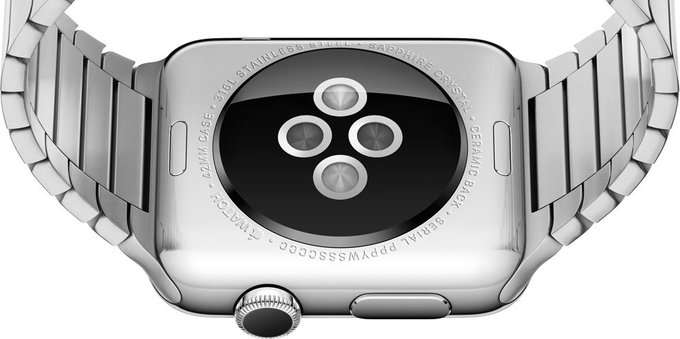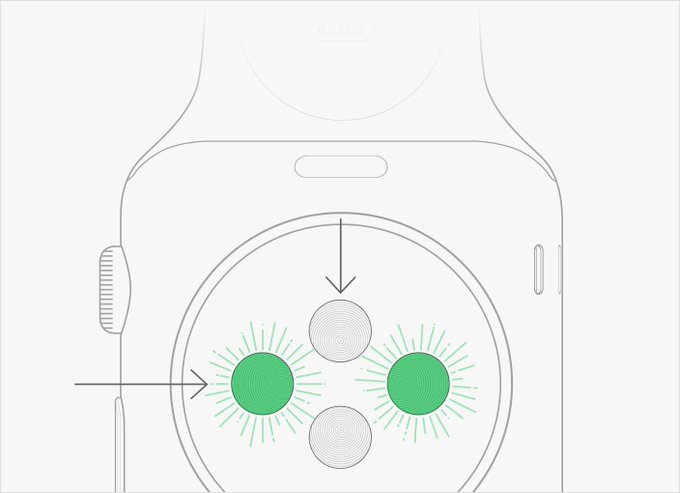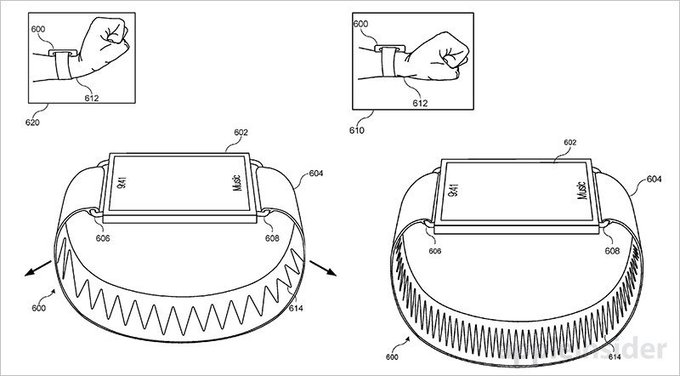Hearts beat a little faster when Apple Watch patents filed on October 13 revealed new cardio technology for the wearable device.
One patent describes a pulse identification system, which could replace other modes of identification like scanning fingerprints or entering your PIN. The other demonstrates how the Apple Watch could respond to gestures like the flick of a wrist.
Here’s what you should know about the latest Apple Watch patents:
1. Future Apple Watch Will Give You a Wrist Workout
In a step to making devices even more hands-free, an Apple patent describes how users can flick their wrists to control their device. The patent notes that sensors on the wristband will read and interpret motions. It added that the Apple Watch may interpret the same motions differently depending on the context of a situation. It’s not hard to imagine a jogger flipping through iTunes tracks with the flick of a wrist.
In addition to recognizing wrist and arm movements, the Apple Watch’s sensors can also detect pressure on its band. Apple Insider reports that the device’s wristband measures hand movement where the pinky and thumb are extended. It adds that the gestures could command the watch to answer a phone call or open a phone app.
2. Blood Reader and Motion Detector Can Simplify the ID Process
Gesture support could work with the blood reader to further simplify the authentication process. For example, raising the device from waist height to head height could start the authentication process, reports Apple Insider.
The Apple Watch uses accelerometers, gyroscopes and GPS radios to read user motion, according to Apple Insider. The blood read uses a pair of light emitters and light sensors to beam light against the skin to gather data on the user’s identity. This technique can calculate the percentage of oxygenated blood in the user.
3. Patent Includes a Camera that Echoes the Apple Ring’s Capabilities

A Future Apple Watch May Have a Camera On its Face (Getty)
The patent also describes a camera along the edge of the watch face that can capture images of bar codes or QR codes. This could be Apple’s push into the wearable scanner field, according to Patently Apple. Apple already filed a patent last year for its Apple Ring, a device with a touch display that can be used with a smart TV, according to Apple.
According to ABI Research, “the devices are quickly migrating out of the gym and into the office, with the wearable scanner market experiencing rapid expansion.” Businesses may be able to use them for taking inventory much more quickly.
The patent also describes a camera on the face of the watch, which can be used to take selfies. Apple revealed the selfie camera in a June patent filing.
4. Current Apple Watch’s Heart Rate Tracker Can Be Turned Into a Pulse Oximeter
While the current Apple Watch had all the necessary gear for pulse oximeters, Apple may have chosen not to activate it because it would require FDA approval as a medical device, reports 9 to 5 Mac.
A teardown of the Apple Watch reveals that its heart-rate monitor can double as a pulse oximeter. One reason Apple may have chosen not to activate it is because it may not be accurate enough. Despite their fancy name, pulse oximeters use infrared light to measure the oxygen content of your blood. Photosensors capture how much light is reflected back to the device. This data can be stored to identify users. Here’s how the pulse oximeter works according to the patent filing:
Due to the difference in absorbance of blood vessels and other tissues, the reflected near-infrared rays produce an image processing techniques producing an extracted vascular pattern. From the extracted vascular pattern, various feature rich data such as vessel branching points, vessel thickness and branching angles are extracted and stored as a template.
A new study published in JAMA Cardiology touts the Apple Watch as the most accurate wrist wearables for fitness tracking.
5. Apple Watch Gesture Support May be Able to Control Other Devices Like a Smart TV
While Android Wear already includes gesture support, Apple Watch may extend its capabilities to control other devices. Tapping into the connected devices market may multiply the possibilities of Apple Watch commands. The patent hints at the ability of Apple Watch to send commands to other devices.
In some embodiments, the function or action invoked by a wrist gesture can including sending control signals to another device that is in communication with the wrist-worn device, thereby allowing wrist gestures to be used for remote control.”




Comments
Apple Watch Patents: 5 Fast Facts You Need to Know